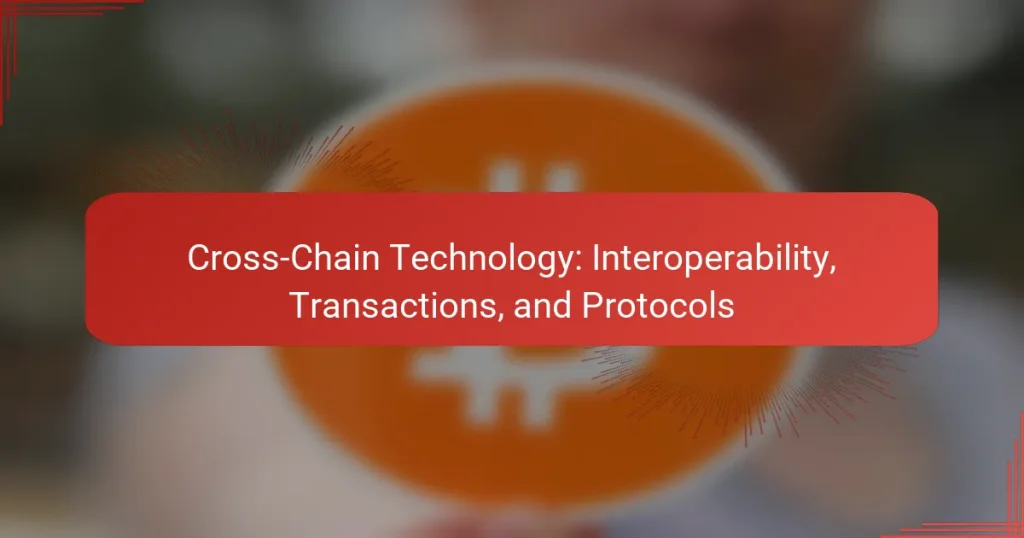Cross-chain technology is revolutionizing the blockchain landscape by enabling interoperability among diverse networks, allowing them to communicate and exchange data seamlessly. This innovation enhances decentralized applications and expands the potential use cases for blockchain technology. Through key cross-chain protocols, transactions can occur smoothly across different platforms, ensuring secure and efficient asset transfers and data sharing.
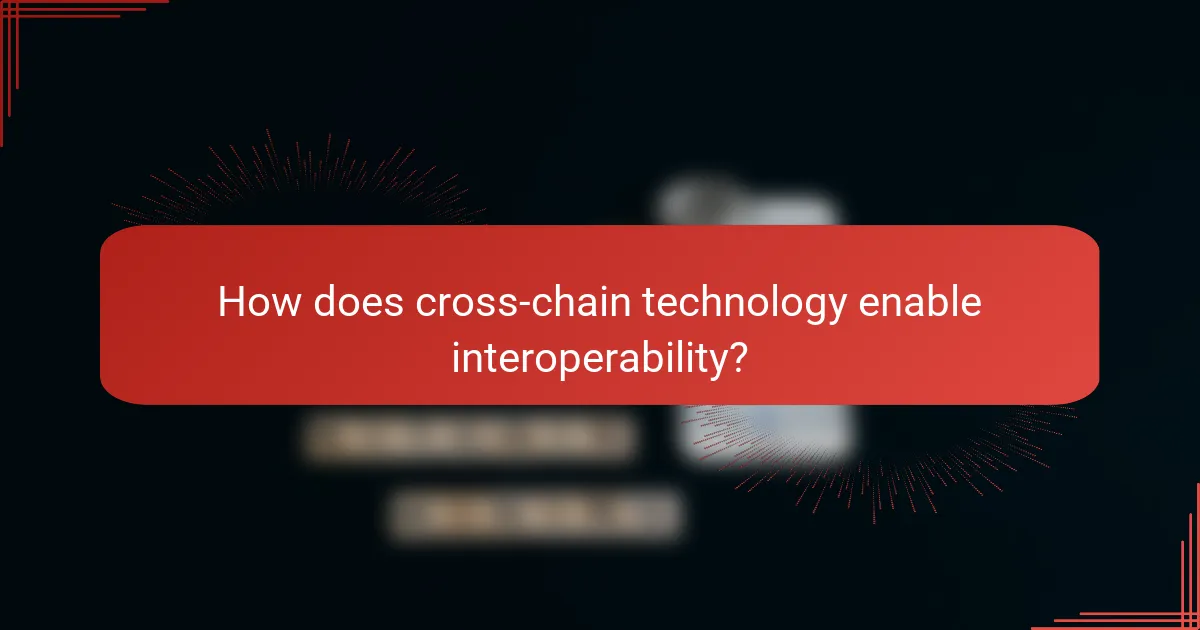
How does cross-chain technology enable interoperability?
Cross-chain technology facilitates interoperability by allowing different blockchain networks to communicate and exchange data seamlessly. This capability enhances the overall functionality of decentralized applications and expands the use cases for blockchain technology.
Interoperability protocols
Interoperability protocols are sets of rules that enable different blockchain networks to interact with one another. These protocols define how data and value can be transferred across chains, ensuring that transactions are secure and efficient. Examples include Polkadot’s Substrate and Cosmos’ Inter-Blockchain Communication (IBC) protocol.
When selecting an interoperability protocol, consider factors such as scalability, security, and community support. A robust protocol can significantly enhance the capabilities of decentralized applications by enabling them to leverage multiple blockchain features.
Blockchain bridges
Blockchain bridges are specialized tools that connect two or more blockchain networks, allowing for the transfer of assets and data between them. They can be centralized or decentralized, with decentralized bridges generally offering greater security and transparency. Examples include the Ethereum-Polygon bridge and the Binance Smart Chain bridge.
When using a blockchain bridge, be aware of potential risks such as smart contract vulnerabilities and liquidity issues. Always verify the bridge’s security measures and transaction fees before proceeding with asset transfers.
Cross-chain atomic swaps
Cross-chain atomic swaps enable users to exchange cryptocurrencies from different blockchains directly without the need for a centralized exchange. This process uses smart contracts to ensure that both parties fulfill their obligations simultaneously, reducing the risk of fraud. For instance, a user can swap Bitcoin for Ethereum directly through an atomic swap mechanism.
To successfully execute a cross-chain atomic swap, both parties must agree on the terms and use compatible wallets. Familiarize yourself with the technical requirements and potential fees associated with the swap to ensure a smooth transaction process.

What are the key cross-chain protocols?
Key cross-chain protocols facilitate interoperability between different blockchain networks, enabling seamless transactions and data exchange. These protocols enhance the overall functionality of blockchain ecosystems by allowing diverse networks to communicate and share resources effectively.
Polkadot
Polkadot is designed to enable different blockchains to transfer messages and value in a trust-free fashion. It achieves this through a unique architecture that includes a central relay chain and multiple parachains, which can operate independently while benefiting from shared security.
When using Polkadot, developers can create specialized blockchains tailored to specific applications, while still being able to interact with other chains. This flexibility makes it a popular choice for projects that require scalability and interoperability.
Cosmos
Cosmos aims to create an “Internet of Blockchains” by allowing various independent blockchains to interoperate. It utilizes the Inter-Blockchain Communication (IBC) protocol, which enables the transfer of tokens and data between different chains securely and efficiently.
One of the key advantages of Cosmos is its modular framework, which allows developers to build custom blockchains that can easily connect to the Cosmos Hub. This approach fosters innovation while maintaining the ability to communicate across different networks.
Chainlink
Chainlink is primarily known for its decentralized oracle network, which connects smart contracts with real-world data. While not a traditional cross-chain protocol, it plays a crucial role in enabling interoperability by providing reliable data feeds across multiple blockchains.
By integrating Chainlink oracles, developers can enhance the functionality of their smart contracts, allowing them to react to external events and data from various sources. This capability is essential for applications that require accurate and timely information from outside their native blockchain environment.
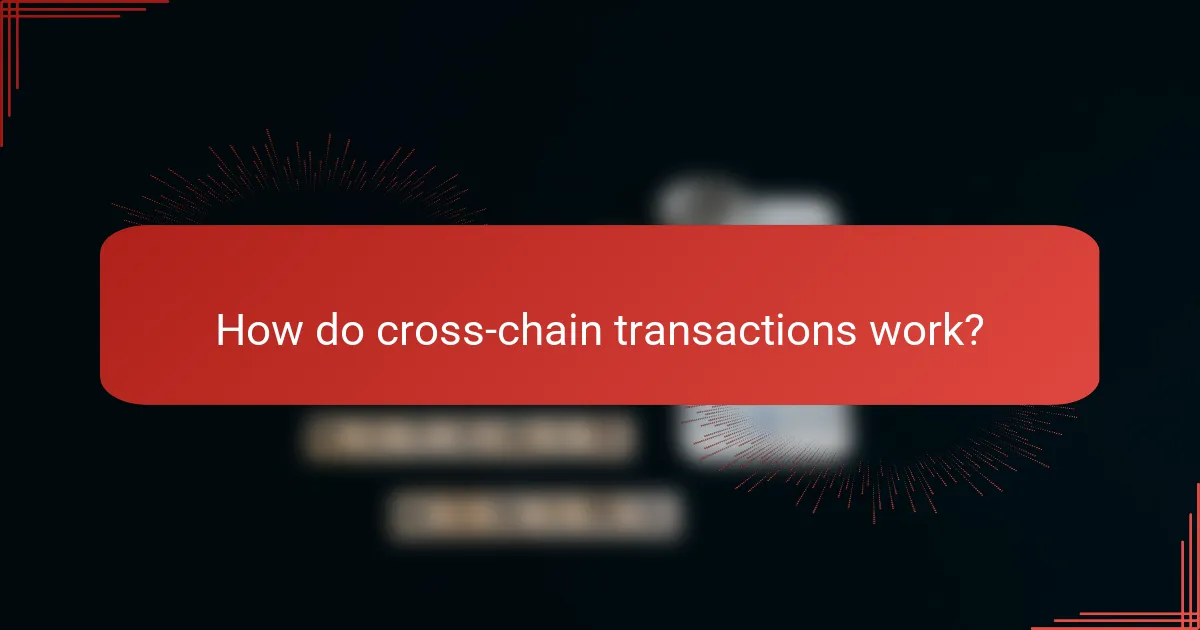
How do cross-chain transactions work?
Cross-chain transactions enable the transfer of assets or data between different blockchain networks, allowing for greater interoperability. This process typically involves a series of steps that ensure the transaction is validated and executed across multiple platforms without compromising security.
Transaction validation process
The transaction validation process in cross-chain transactions often relies on protocols that facilitate communication between blockchains. These protocols, such as atomic swaps or relay chains, ensure that both parties in a transaction agree on the terms before any assets are transferred.
For example, in an atomic swap, the transaction is locked in a smart contract on both blockchains, ensuring that either both transactions complete successfully or neither does. This mechanism minimizes the risk of fraud and enhances trust between users.
Smart contract execution
Smart contracts play a crucial role in executing cross-chain transactions by automating the transfer of assets based on predefined conditions. When a transaction is initiated, the smart contract checks the validity of the transaction on both blockchains before executing the transfer.
For instance, if a user wants to swap Bitcoin for Ethereum, the smart contract will verify the availability of the Bitcoin and the corresponding Ethereum amount before proceeding. This execution method reduces the need for intermediaries and speeds up the transaction process.
Transaction fees comparison
Transaction fees for cross-chain transactions can vary significantly depending on the blockchains involved and the complexity of the transaction. Generally, fees may range from a few cents to several dollars, influenced by network congestion and the specific protocols used.
For example, Ethereum transactions tend to have higher fees during peak times compared to Bitcoin, which may have lower fees but longer confirmation times. Users should evaluate the fee structures of both blockchains before initiating a cross-chain transaction to ensure cost-effectiveness.
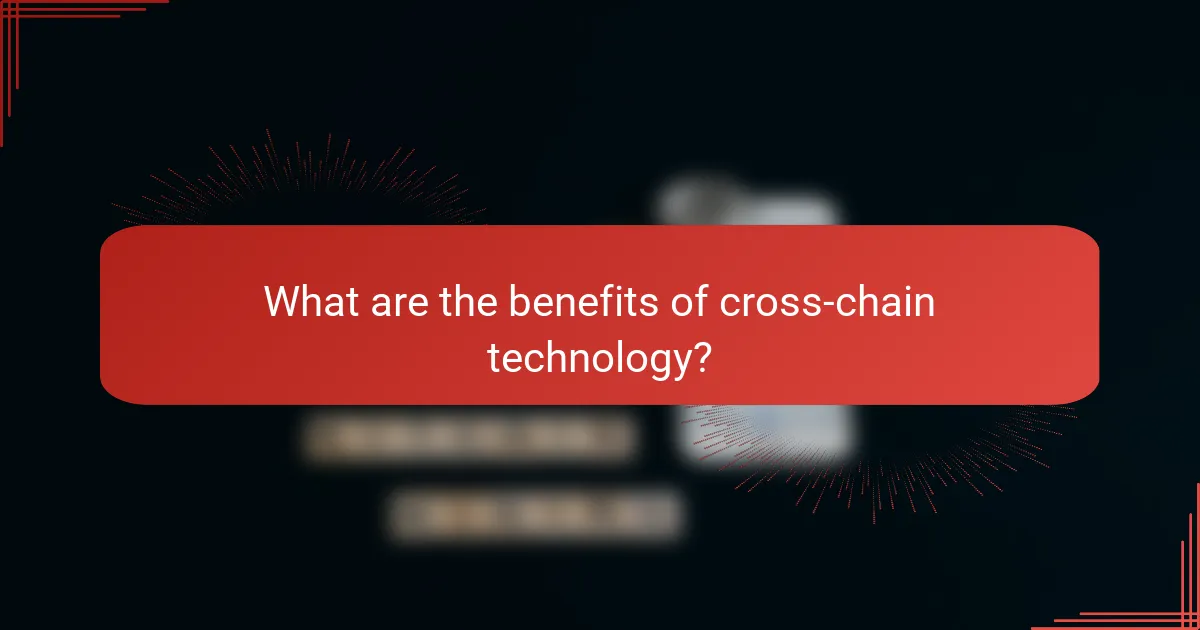
What are the benefits of cross-chain technology?
Cross-chain technology enables different blockchain networks to communicate and interact, offering several advantages such as increased liquidity, enhanced user experience, and broader asset accessibility. These benefits facilitate smoother transactions and a more integrated ecosystem for users and developers alike.
Increased liquidity
Cross-chain technology enhances liquidity by allowing assets to move freely between different blockchains. This interoperability enables users to access a wider range of trading pairs and markets, which can lead to better price discovery and reduced spreads.
For example, if a user holds an asset on one blockchain, they can seamlessly trade it for another asset on a different blockchain without needing to convert it to a fiat currency first. This fluidity can attract more participants to the market, further boosting liquidity.
Enhanced user experience
By integrating multiple blockchains, cross-chain technology simplifies the user experience. Users can interact with various decentralized applications (dApps) and services without needing to manage multiple wallets or navigate complex exchanges.
For instance, a user can utilize a single wallet to access services across different platforms, streamlining transactions and reducing the time spent on managing assets. This convenience can encourage more users to engage with blockchain technology.
Broader asset accessibility
Cross-chain technology broadens asset accessibility by allowing users to trade and utilize a diverse array of cryptocurrencies and tokens across different networks. This opens up investment opportunities that were previously limited to specific blockchains.
For example, a user interested in a token on a less popular blockchain can easily acquire it through a more widely used network, increasing their investment options. This accessibility can lead to a more inclusive financial ecosystem, benefiting users globally.

What challenges does cross-chain technology face?
Cross-chain technology faces several significant challenges, including security vulnerabilities, scalability issues, and regulatory concerns. These obstacles can hinder the seamless transfer of assets and information between different blockchain networks.
Security vulnerabilities
Security vulnerabilities are a major concern in cross-chain technology, as they can expose networks to attacks. For instance, if a bridge connecting two blockchains is compromised, malicious actors could exploit it to steal assets or manipulate transactions.
To mitigate these risks, developers should implement robust security protocols, such as multi-signature wallets and regular audits. Users should also be cautious and only utilize well-established cross-chain solutions with a proven track record.
Scalability issues
Scalability issues arise when cross-chain transactions increase, potentially leading to network congestion. As more users engage in cross-chain activities, the speed and efficiency of transactions can decline, resulting in longer confirmation times and higher fees.
To address scalability, projects can adopt layer-2 solutions or optimize their consensus mechanisms. For example, utilizing sidechains can help distribute the load and maintain performance during peak usage.
Regulatory concerns
Regulatory concerns pose a challenge for cross-chain technology, as different jurisdictions have varying laws governing cryptocurrencies and blockchain transactions. This inconsistency can create uncertainty for users and developers alike.
To navigate these regulations, stakeholders should stay informed about local laws and engage with legal experts. Establishing compliance frameworks that adapt to different regulatory environments can also facilitate smoother cross-chain operations.
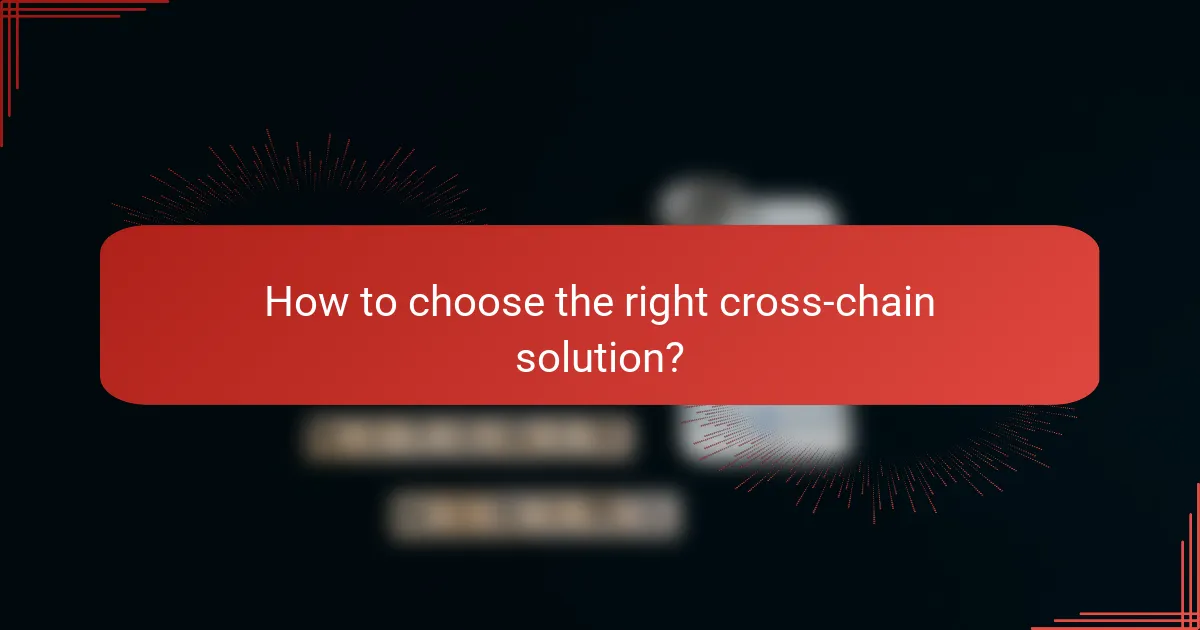
How to choose the right cross-chain solution?
Selecting the right cross-chain solution involves assessing compatibility, transaction speed, and security features. Consider how well the solution integrates with existing systems and the specific needs of your use case.
Evaluation criteria
When evaluating cross-chain solutions, focus on key criteria such as interoperability, transaction fees, and scalability. Ensure the solution supports multiple blockchain networks and can handle the volume of transactions your application requires.
Security is paramount; look for solutions that utilize robust encryption and have undergone thorough audits. Additionally, consider the community and developer support, as a strong ecosystem can enhance the solution’s reliability and future updates.
Use case analysis
Analyze your specific use case to determine the most suitable cross-chain solution. For instance, if your project involves asset transfers between different blockchains, prioritize solutions that offer fast transaction speeds and low fees.
For applications requiring frequent interactions between chains, such as decentralized finance (DeFi) platforms, consider solutions that provide seamless integration and high throughput. Evaluate potential trade-offs, such as the balance between decentralization and performance, to align with your project goals.
